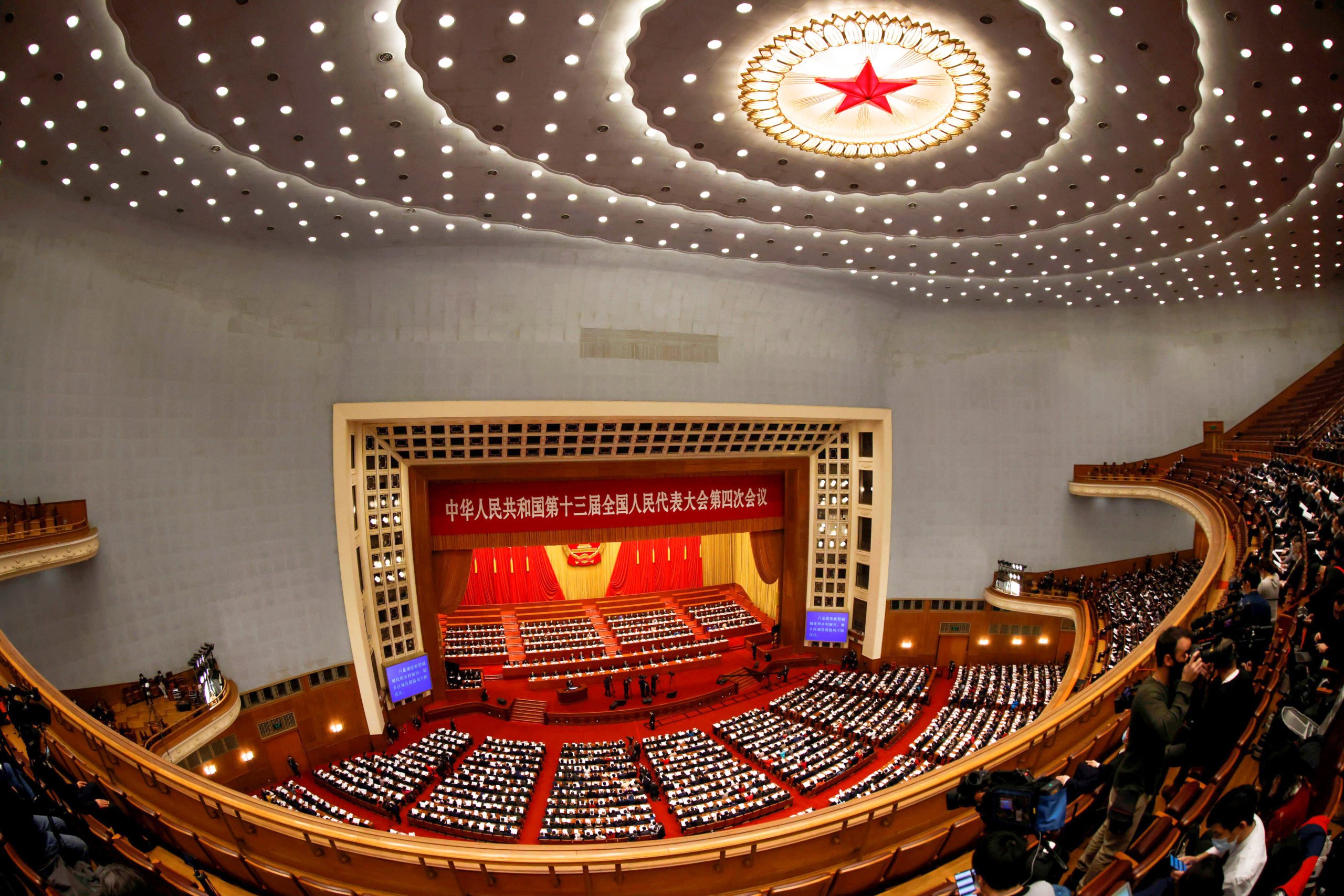China last week released its 14th Five Year Plan (FYP), a top-level policy blueprint for the next five years that has been much anticipated since the country made its pledge in September last year to achieve carbon neutrality by 2060.
The plan, for 2021-2025, was released in draft form for approval at the annual session of China’s top legislature, the National People’s Congress (NPC). Chinese media had expected a central place for carbon neutrality, but the 2060 goal was only mentioned once in the 148-page document. The climate-related targets for 2025 were also lower than expected.
Yet unlike the two previous FYPs the document does not set economic growth targets. Experts interviewed by China Dialogue welcomed this break from the growth-at-all-costs mentality, though they were disappointed that the plan only takes “baby steps” towards decarbonisation.
No growth target
China has been issuing FYPs since the 1950s. The policy targets laid down in these plans are considered the paramount indicators guiding China’s economic and social development over the following five years. Strict top-down appraisals make sure the various bodies that make up the country’s vast government apparatus meet the targets or face consequences. The draft FYP released on Friday is expected to be approved unchanged by the NPC on 11 March.
Uncertainties brought about by the ongoing pandemic and its economic impacts have overshadowed the drafting of the 14th FYP. Ahead of this year’s NPC session, leading Chinese economists, including central banker Ma Jun, suggested that no numerical GDP growth targets should be set out in the plan. Such targets, they argued, perpetuate an unsustainable debt-driven model of growth. With local governments keen to demonstrate their enthusiasm, China overshot its annual growth targets in both the 12th and the 13th FYP periods up to 2019, before Covid-19 hit – this was often achieved through investment in big projects financed by loans.
The newly released draft reflects these concerns. Instead of setting annual GDP growth targets for the next five years, it lays out a new system of issuing “indicative economic growth targets” every year based on actual circumstances. For this year, GDP growth is expected to reach 6%, according to figures released at the NPC session.
Professor Zhu Dajian, director of Tongji University’s Institute of Sustainable Development and Management, told China Dialogue that leaving out the economic growth target reflects China’s commitment to development that is both high quality and low carbon. “Six per cent for 2021 is a deliberately modest year-on-year target given last year’s poor economic performance,” he said. Due to Covid-19, China’s GDP only grew by 2.3% in 2020.
Lauri Myllyvirta, an analyst with the Centre for Research on Energy and Clean Air (CREA), considers the absence of growth targets “potentially good news for the environment,” as “it should give the government more flexibility to pursue other targets, and reduce the pressure to prop up GDP numbers at all costs.”
No definitive emissions trajectory
However, without GDP targets, it is difficult to assess the plan’s impact on China’s carbon emissions trajectory over the next five years, as its key climate targets are pegged to the performance of the Chinese economy.
Ahead of the release, climate experts had called for the inclusion of a carbon emissions cap. But the draft does not contain one. Instead, it continues with the approaches of previous FYPs in setting energy intensity and carbon intensity targets per unit of GDP. By 2025, according to the new FYP, China is to reduce energy intensity by 13.5% from 2020 levels, and carbon intensity by 18%. The country will also boost the share of non-fossil sources in its energy mix to “around 20%” by the end of the period.
CREA’s Myllyvirta calculates that, on average, China’s carbon dioxide emissions rose by 1.7% each year during the 13th FYP period (2016-2020). Despite low economic growth last year, emissions increased 1.5% year on year, approaching 10 billion tonnes in total. Assuming China’s GDP grows at an annual rate of 5.5% from 2021 to 2025, carbon emissions will still rise by 1.1% each year.
Last year, researchers at Tsinghua University’s Institute for Climate Change and Sustainable Development (ICCSD), who modelled China’s roadmap to carbon neutrality by 2060, projected that China could achieve a carbon emissions peak of around 10.5 billion tonnes shortly before 2030. This relied upon annual economic growth slowing to 5.3% during the 14th FYP period and 4.8% during the 15th FYP period, plus more aggressive carbon intensity cuts. Based on the results of this modelling, they recommended setting a carbon intensity reduction target of above 19%, and an energy intensity reduction target of 14% in the 14th FYP.
Since President Xi Jinping announced China’s 2060 carbon neutrality goal at the UN General Assembly last year, many organisations and experts have called on the country to set more ambitious targets to achieve peak carbon around 2025 instead of 2030. A recent study by the World Resources Institute (WRI) argued that earlier peaking could be worth a net value of US$1 trillion in social and economic benefits for China.
But based on the targets in the 14th FYP, China has no plans to accelerate its actions on climate.
He Lifeng, director of the National Development and Reform Commission (NDRC), China’s top economic planning agency, told reporters on Friday that the 14th FYP targets were created to be “high-hanging fruit” – achievable, but only with effort. Yet many experts believe that the targets will not be difficult to meet as long as China continues its current pace of renewables deployment and energy transition.
Dr Yang Fuqiang, a research fellow at Peking University’s Research Institute for Energy, told China Dialogue that the plan’s two intensity targets are lower than expected. “It’s common for the government to set targets that leave a margin of error so that it can over-achieve rather than fail to meet them,” he said. But he argued that China should change this mentality and use more ambitious targets to drive higher-quality development: “If the bars are set too low, they have less power to motivate.”
Non-fossil sources of energy and coal
As already outlined, the 14th FYP also contains a target for non-fossil fuels, which includes nuclear and hydropower, to make up around 20% of China’s energy mix by 2025. The figure currently stands at about 16%. But unlike the last FYP, the energy mix is no longer in the “binding targets” section. Instead, the 20% target was only included in the main text of the document. This difference may affect how the target is appraised by the central government. Binding targets are usually subject to more rigorous scrutiny.
Even though the plan does not contain an absolute carbon emissions cap, it does say that carbon intensity controls will be “supplemented” by controls on total emissions. Yang Fuqiang believes this wording reflects concerns surrounding the impact of the pandemic, and the disruption it has caused to the global economy. As such, rather than issuing emissions quotas in a top-down manner, an economy-wide carbon cap has been kept as a tentative option, inviting provinces to come up with bottom-up initiatives to control emissions.
Zou Ji, president of the Energy Foundation China, expressed concern about this in an interview with China Dialogue: “Carbon peaking is, in essence, about managing absolute total emissions. Without an absolute emissions target, how can we make sure that emissions go down?” He suggested that in the absence of a nationwide carbon cap, sectoral and provincial caps should be established.
Wang Jinnan, director of the Institute for Environmental Planning under the Ministry of Ecology and Environment, proposed that China should set up a “tiered” system for total carbon emissions over the next five years, with some regions and sectors hitting peak emissions sooner. He also said that a comprehensive nationwide carbon emissions monitoring, reporting and verification system should be established.
Many believe that China hasn’t needed coal power to meet its growing energy needs since the beginning of the 13th FYP period, but the 14th FYP still contains multiple references to the development of coal and other fossil fuel energy sources, albeit under the condition of “clean and efficient utilisation”. The plan places a heavy emphasis on protecting China’s energy security in the face of a global energy landscape undergoing “fundamental changes” – as such, maintaining domestic production is part of an overarching energy security strategy.
“It’s disappointing that China is placing such a large focus on continuing its reliance on coal – and oil and gas. The world is relying on its largest emitter to step up on climate change, yet we see little of such action in this plan,” said Swithin Lui of NewClimate Institute.
Li Shuo, senior policy advisor at Greenpeace East Asia, commented: “There’s still no end in sight for China’s coal plant construction boom… China won’t be back on the decarbonisation pathway until Beijing checks the coal construction boom and greens its Covid recovery.”
Some experts think China will include a coal consumption cap in its Special 14th FYP for Energy Development. Once the national-level FYP is passed by the NPC, special ministry-, sector- and province-level plans will be created in the coming months. The Special 13th FYP for Energy Development set a coal consumption cap of 4.1 billion tonnes and an energy consumption cap of 5 billion tonnes of coal equivalent (TCE) . ICCSD researchers at Tsinghua University have recommended an energy consumption cap of 5.5 billion TCE for the 14th FYP period.
According to the National Bureau of Statistics, in 2020 coal provided 56.8% of the total energy consumed by China, an historic low. But Yang Fuqiang believes this figure could be brought down to below 50% in the 14th FYP period, given how fast renewables are developing in China. To achieve this, he suggests the Special 14th FYP for Energy Development should include a lower share for coal (of below 50%) as a binding target.








![Indian father riding on at electric three wheeler with his child [image: Suman Kumar / Alamy]](https://dialogue.earth/content/uploads/2021/05/2BHEFB6-300x200.jpg)
